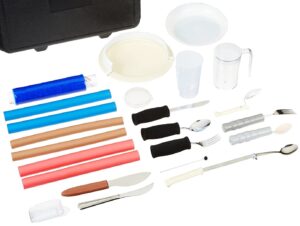Adaptive Feeding
Feeding/eating is a simple act for many but can be challenging for some and even dangerous for others. (Any concerns regarding feeding/eating and/or swallowing should be brought up with a medical professional.) If you have weakness, tremors, arthritis, or other challenges in your upper body, you might find bringing food and liquid to your mouth a difficult task. These difficulties can result in other health issues such as: weight loss, depression, blood sugar changes, and loss of appetite. However, the use of adaptive devices, utensils, cups, and plates will allow you bring the food and liquid to your mouth with more success and maintain your independence.
Silverware
- Weighted – Weighted utensils typically have a larger diameter handle and give you more feedback and coordination when spearing, scooping, and/or cutting food. They are especially helpful if you suffer from tremors.

- Large grip – Large grip utensils are useful if you have hand weakness, pain in the hand joints, and endurance issues. They can have different surfaces from smooth to textured to improve your grip.

- Curved – Curved utensils may have a fixed curve while others can be bent to the curve that suits you. Sill others are on a swivel/movable hinge to meet your needs. These utensils can help if you have limited coordination, decreased range of motion, and/or pain with joint movement.

- Cuffs/straps & Holders – Using a cuff sometimes called a “universal cuff” allows you to use any utensil and it slides into a pocket of fabric that goes around your hand. Holders are usually rigid straps that go over the hand. You do not need to grasp the utensil with your hand to eat.

Dinnerware
- Scoop Plates & Bowls – Scoop plates and bowls have a built up/curved side so that you do not need as many hand/wrist movements to get food on a utensil. They also often have a non-skid bottom to keep them from sliding if you cannot stabilize them using your other hand.

- Food Guards – Food guards are usually removeable semi-circular barriers that clip onto any plate. They keep your food from being pushed off the plate and make scooping easier.
- Suction Cups – Suction cups frequently are attached to scoop plates/bowls but also can be found separately to attach to standard plates/bowls. They keep the plate from sliding off the table.

Cupware
- Cut outs – Cut-out cups will help if you have limited range of motion and/or swallowing problems. A small section of one side of the top of the cup is removed so you can drink without tipping your head back.

- Weighted – Weighted cups help to lessen tremors and reduce spills when placing the cup down.

- Curved Handles – Curved handle cups can help if you have trouble grasping and/or holding onto the cup.

- Straws & Spouts – The use of straws helps with decreased neck/arm movement, decreased strength, and swallowing issues. You can take in the liquid needed without as much motion & coordination while maintaining a more ideal swallowing position. The spouts can help reduce spills while controlling the flow of liquid to limit choking.

